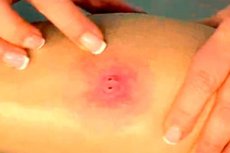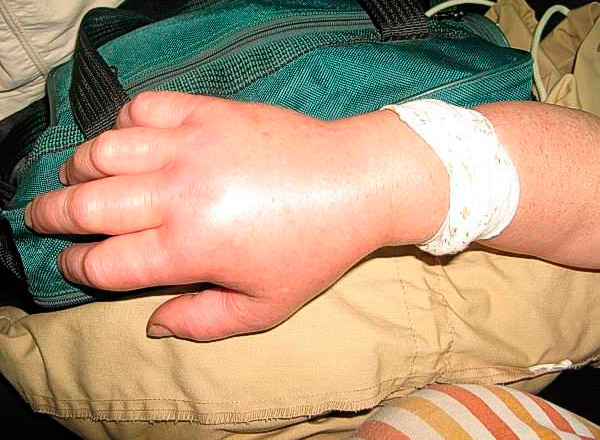Medical expert of the article
New publications
Consequences after a viper bite
Last reviewed: 07.07.2025

All iLive content is medically reviewed or fact checked to ensure as much factual accuracy as possible.
We have strict sourcing guidelines and only link to reputable media sites, academic research institutions and, whenever possible, medically peer reviewed studies. Note that the numbers in parentheses ([1], [2], etc.) are clickable links to these studies.
If you feel that any of our content is inaccurate, out-of-date, or otherwise questionable, please select it and press Ctrl + Enter.

Today, people increasingly seek medical help with various injuries, damages, especially after outdoor recreation. One of the most serious injuries is a viper bite. It causes serious disruptions in the functional state of the body, and can also cause the development of an allergic reaction, edema, anaphylactic shock. Bites do not always end in death, however, if first aid is not provided in a timely manner, it can end in death.
The most dangerous complication is severe poisoning of the body, in which the poison affects the entire body and has a systematic effect. At this time, the most local edema develops, which is accompanied by pain, swelling, redness, and an increase in local temperature.
The process may be accompanied by circulatory disorders, minor hemorrhages. An allergic reaction is also dangerous, especially if it develops in an immediate manner. The risk of developing anaphylactic shock increases, which is accompanied by suffocation, progressive edema, loss of consciousness, and a fatal drop in temperature and blood pressure.
Swelling after a viper bite
Edema is a fairly common reaction that occurs in response to a toxin (poison) entering the body. Edema develops especially intensely against the background of an allergic reaction, reduced immunity. Edema is usually local.
Edema may be accompanied by circulatory disorders, blood function disorders. Vascular thrombosis and hemorrhages in internal organs develop. Infection and inflammation may become dangerous. As a result, edema increases, vascular thrombosis develops, and local metabolic disorders develop, which, in the absence of adequate treatment, may progress to the point of tissue necrosis.

As a result of the poison's action, severe damage to muscles and nervous tissue may occur, which is accompanied by loss of sensitivity, reactivity, and weakening. As a rule, muscles weaken, fingers stop bending (if the limbs are affected).
Systemic poisoning may be accompanied by an increase in general and local temperature, nausea, vomiting, and chills. The activity of the heart muscle worsens, which may progress to the development of severe heart failure. The load on the liver and kidneys also increases significantly, which may result in an inflammatory process, a functional disorder, including renal and hepatic failure. Blood pressure changes. In some cases, hypotension develops, in others - hypertension. The process may be accompanied by blood loss, including internal, weakness, and clouding of consciousness.
The process may be accompanied by convulsions, tremors, shaking in the limbs. All this may be accompanied by increasing excitement, euphoria. As a rule, in the absence of treatment, a fatal outcome develops. Death can occur in a period from 30 minutes to 2-3 days.
Necrosis after a viper bite
It is an inflammation and subsequent death of damaged areas of the body. Necrosis from a biological point of view, necrosis means the death of damaged tissues of the human body. In this case, the process is progressive. It is carried out in order to prevent the development of infection or intoxication in the entire body. So, if a limb is damaged, in which most of the tissues and cells progressively die. But in order to prevent infection of the entire body and to prevent similar death of tissues on the legs, torso, another limb, amputation of the limb may be required.
Thus, necrosis after a viper bite means tissue death at the site of the snake bite. To prevent adverse effects in the form of necrosis, the cause should be determined and eliminated: this is the only way to eliminate or stop the process of death.
Do people die from a viper bite?
Although many people survive a viper bite, it cannot be said that it is safe. A viper is a poisonous snake, so its bite can be fatal. Everything depends on the quality and speed of emergency care. If you start providing first aid immediately after a bite, the person will survive. You need to suck out the poison immediately. If you do not do this within 3-5 minutes after the bite, it is absorbed, penetrates the body and begins to affect the internal organs, already having a systemic effect on the body. This can be fatal.
Treatment of the effects of a viper bite
Folk and homeopathic remedies effectively help against edema. Let's consider the most effective remedies.
An ointment made from spring chestnut leaves has proven itself well. To prepare it, take several chestnut leaves, grind them, and then set them on fire. After the leaves have completely burned and ash remains, add 2-3 drops of fir essential oil, as well as 2-3 tablespoons of flower honey.
Mix everything thoroughly, then apply the resulting mass in a thin layer to the affected area. It is advisable to apply it while it is still hot. Repeat this daily until visible bites, redness, and other consequences of the bite disappear.
The main advantage of such a combination of substances is that after burning the chestnut, all dangerous substances that can cause irritation and increase the inflammatory process are neutralized. At the same time, biologically active substances that promote wound healing remain in the ashes. Fir oil promotes skin renewal and accelerates regenerative processes. Honey enhances the activity of all other components included in the ointment. Honey also sucks out the remains of poison from the wound, relieves inflammation, allergic reactions, dissolves seals, swelling and hematomas. If there is no resinous mass left after burning, you can dilute the resulting ash in half a glass of warm water, and then add all the other components.
An ointment made from honeysuckle decoction and honey also works well. To prepare the ointment, take about 50 grams of honey, melt it in a water bath, add the honeysuckle decoction prepared in advance, stir until a homogeneous mass is formed, and allow it to harden. After this, apply a thin layer to the affected area 3-4 times a day. It helps to eliminate a viper bite already on the 4-5th day after the start of treatment.
Read more about treatment after a viper bite in this article.


 [
[